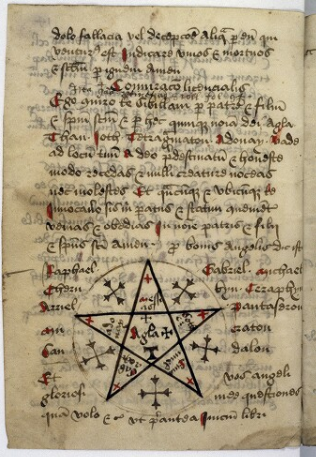Hélène Colleu
(POLEN [POuvoirs, LEttres, Normes], Université d’Orléans)
“Alia experimentum cristalli pro puero:
Scrying in a 15th century nigromantic manuscript”
Abstract of Paper
Intended To be presented at the 55th International Congress on Medieval Studies [CANCELLED]
(Kalamazoo, 2020)
Rescheduled for the 56th International Congress on Medieval Studies
(Kalamazoo, 2021)
Session I of II on
“Revealing the Unknown”
Part I: “Scryers and Scrying in the Middle Ages and Early Modern Period”
Sponsored by the Research Group on Manuscript Evidence and the Societas Magica
Organized by Sanne de Laat and László Sándor Chardonnens
2020 Congress Program
2021 Congress Program Planning
[Published on 22 March 2020, reporting the Cancellation of the Congress as a whole,
with an Update on 19 November 2020 reporting the Resheduling for the 2021 Congress]
*****
Abstract
Rawlinson D252 is an English manuscript in the Bodleian Library in Oxford. This small handbook, made of parchment, was written during the 15th century by two anonymous scribes with a keen interest in nigromantic magic. It consists of a compilation of various divinatory and exorcistic recipes, also called experimenta, which often enlist the help of demons, angels, and other spirits to solve various problems. Written in Latin and in Middle English, this manuscript, containing only practical texts instead of theoretical ones, is similar to some extent to the one published by Richard Kieckhefer in 19981.
Most of these recipes are divinatory in nature. Those specific experimenta reveal information about missing objects, hidden treasures, or the conjuring of more or less benevolent spirits to answer questions about past, present, or future events. Various kinds of divinatory techniques are used, such as ritual magic, hydromancy, etc. Among those techniques, scrying has a special place in the book. Through crystals, mirrors, or even nails, the manuscript reveals in a dozen recipes many ways and uses of scrying, which we wish to analyze step by step.
First, we will list each term and object referring to scrying, and analyze their uses. Berillo, speculo vel vitro, are some of the many terms used in the experimenta, which raise some questions. For example, can a mirror be explicitly switched for a gemma cristalli in the same recipe? In which case are they used?
The preparation of scryer and tools, are also minutiously detailed. Masses, cleaning, oiling, and so on can be essential steps. The object used for scrying is not only a part of the magic ritual, but also the focus of its own preparative ritual. The place and time of the rituals and of the scrying itself are also significant.
Beyond the rituals, the practitioners themselves also raise questions. Indeed, the manuscript mentions on several occasions that the magister is not able to see by himself. In most experimenta, a child is the only person able to communicate with the conjured spirit or to pass on information. Such practice must be compared with antique and medieval ones, as John of Salisbury testified2.
Then, the point of scrying itself should be questioned. First, what is the magister seeking? Missing goods and persons, questions about the future, etc.” Next, how are these things revealed: Is the object or event directly represented on the surface, or is there always an intermediary? In the case of a conjuring, the spirit is commonly ordered to appear under a certain form, and with a particular look.
Lastly, this manuscript handbook is a unique source of material to study the natures, functions and uses of divinatory objects and scrying devices in particular. Scrying implies the choice of a medium, but it is also a support of destinative magic, since in many cases, an intermediary appears in order to answer questions. It also questions the incorporation of scrying in a larger system of ritual magic. Finally, more than a purely intrinsic study, such practices should be put in perspective with older practices, and with their inheritances in other early modern English manuscripts.
_____
1 Richard Kieckhefer, Forbidden Rites: A Necromancer’s Manual of the Fifteenth Century (Pennsylvania: Penn State Press,
1998).
2 John of Salisbury, Policraticus I-IV, ed. Katharine Keats–Rohan. CCCM 118 (Turnhout: Brepols, 1993), book II, chap. 28.
*****

Photo: © Bodleian Libraries, University of Oxford. Rawlinson MS D. 352, folio 104v. Image via Creative Commons.
